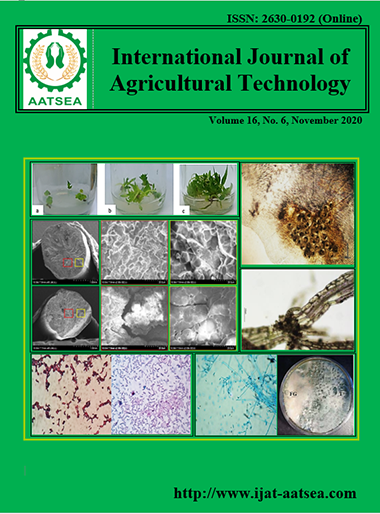Development of sterilized durian cake roll
Main Article Content
Abstract
The development of durian cake roll was investigated by using a sterilization process for extending its shelf life. The first study was reported the durian cream filling with the sterilized conditions of 121°C for 15 minutes. Two types of commercial modified starch (SMS and SPF) were studied with concentrations of 6, 8 and 10% to improve the quality of the sterilized durian cream filling. The increased concentrations of both modified starches caused to increase firmness in cream. Sensory evaluation showed higher liking score on odor, taste and overall acceptance in cream with SMS modified starch than the control. The durian cake roll was improved by three hydrocolloids with different concentrations (Hydroxypropyl methylcellulose 0.8, 1.0%, Carboxymethyl cellulose 0.5, 1.0%, Xanthan gum 0.5 and 1.0%) and improved the sterilized durian cake roll. CMC of 1.0 % affected higher liking score on taste, texture and overall acceptance than trhe control which significantly lowest hardness on texture measurement. The change of durian cake roll was stored at 35 and 55°C for four weeks. Result showed that the tendency of increase in hardness and decrease in springiness of sterilized durian cake roll when kept in storage with temperature and time. Microbiology analysis using total plate count and yeast and mold count of both storage at 35 and 55°C for four weeks were lower than 1 x 101 CFU which requires for Thai regulated standard.
Article Details

This work is licensed under a Creative Commons Attribution-NonCommercial-NoDerivatives 4.0 International License.
References
Albaali, G. and Farid, M. (2006). Sterilization of food in retort pouches. Springer.
AOAC (2000). Official methods of analysis. Association of Officaial Analytical Chemists International. Maryland, USA.
BeMiller, J. N. (2019). 8 - Cellulose and Cellulose-Based Hydrocolloids Carbohydrate Chemistry for Food Scientists (Third Edition), AACC International Press, pp. 223-240.
Durance, T. D. (1997). Improving canned food quality with variable retort temperature processes. Trends in Food Science & Technology, 8:113-118.
Dziezak, J. D. (1991). A focus on gums. Food Technology, 45:116-132.
Gómez, M., Ronda, F., Caballero, P. A., A. Blanco, C. and Rosell, C. (2007). Funcionality of different hydrocolloids on the quality and shelf life of yellow layer cakes. Food Hydrocolloids, 21:167-173.
Guynot, M. E., Ramos, A. J., Sala, D., Sanchis, V. and Marı́n, S. (2002). Combined effects of weak acid preservatives, pH and water activity on growth of Eurotium species on a sponge cake. International Journal of Food Microbiology, 76:39-46.
Hedegaard, R. V. and Skibsted, L. H. (2013). 16 - Shelf-life of food powders Handbook of Food Powders, Woodhead Publishing, pp. 409-434.
Kishida, T., Nakai, Y. and Ebihara, K. (2001). Hydroxypropyl-Distarch Phosphate from Tapioca Starch Reduces Zinc and Iron Absorption, but not Calcium and Magnesium Absorption, in Rats. The Journal of Nutrition, 131:294-300.
Membré, J.-M., Kubaczka, M. and Chèné, C. (2001). Growth rate and growth–no-growth interface of Penicillium brevicompactum as functions of pH and preservative acids. Food Microbiology, 18:531-538.
Mezaize, S., Chevallier, S., Le Bail, A. and de Lamballerie, M. (2009). Optimization of gluten-free formulations for French-style breads. Journal of Food Science, 74:E140-146.
Mohammadi, M., Sadeghnia, N., Azizi, M. H., Neyestani, T. R., and Mortazavian, A. M. (2014). Development of gluten-free flat bread using hydrocolloids: Xanthan and CMC. Journal of Industrial and Engeineering Chemistry, 20:1812-1818.
Özay, I. and Özyıldırım, B. A. (2017). Food safety and food-borne illness approach of healthcare workers. International Journal of Food Safety, Nutrition, Public Health and Technology, 9:7-19.
Pinsorn, P., Oikawa, A., Watanabe, M., Sasaki, R., Ngamchuachit, P., Hoefgen, R., Saito, K. and Sirikantaramas, S. (2018). Metabolic Variation in the Pulps of Two Durian Cultivars: Unraveling the Metabolites that Contribute to the Flavor. Food Chemistry, 268.
Pither, R. J. (2003). Canning Quality Changes During Canning Encyclopedia of Food Sciences and Nutrition (Second Edition), Oxford: Academic Press, pp. 845-851.
Ranjbar, S., Movahhed, S., Nematti, N., and Sokotifar, R. (2012). Evaluation of the Effect of Carboxy Methyl Cellulose on Sensory Properties of Gluten-Free Cake. Research Journal of Applied Sciences, Engineering and Technology, 4:3819-3821.
Rutenberg, M. W. and Solarek, D. (1984). CHAPTER X - STARCH DERIVATIVES: PRODUCTION AND USES Starch: Chemistry and Technology (Second Edition), San Diego: Academic Press, pp. 311-388.
Saha, D. and Bhattacharya, S. (2010). Hydrocolloids as thickening and gelling agents in food: a critical review. Journal of food science and technology, 47:587-597.
Sangsawang, S. (2004). Shelf-life extension of taro pie using humectant and modified atmosphere packaging. (Master Thesis), Chulalongkorn University, Thailand.
Saranraj, P. and Geetha, M. (2012). Microbial Spoilage of Bakery Products and Its Control by Preservatives. International Journal of Pharmaceutical & Biological Archives 3.
Shi, X. and Bemiller, J. (2002). Effects of food gums on starch suspensions during pasting. Carbohydrate Polymers, 50:7-18.
Sofos, J. N. and Busta, F. F. (1981). Antimicrobial Activity of Sorbate. Journal of Food Protection, 44:614-622.
Stewart, C. M., Cole, M. B. and Schaffner, D. W. (2003). Managing the Risk of Staphylococcal Food Poisoning from Cream-Filled Baked Goods To Meet a Food Safety Objective. Journal of Food Protection, 66:1310-1325.
Teixeira, A. A. and Tucker, G. S. (1997). On-line retort control in thermal sterilization of canned foods. Food Control, 8:13-20.
Thompson, A. K. (2015). Fruit and vegetables. Harvesting, Handling and Storage Third edition Volume 1 Introduction and Fruit. Oxford, Wiley-Blackwell Publishing.
Vaclavik, V. A. and Christian, E. W. (2014). Food Preservation Essentials of Food Science, New York, NY: Springer New York, pp. 323-342.
Wilderjans, E., Luyts, A., Brijs, K. and Delcour, J. A. (2013). Ingredient functionality in batter type cake making. Trends in Food Science & Technology, 30:6-15.
Yook, C., Pek, U. H., and Park, K. H. (1993). Gelatinization and Retrogradation Characteristics of Hydroxypropylated and Cross-linked Rices. Journal of Food Science, 58:405-407.


